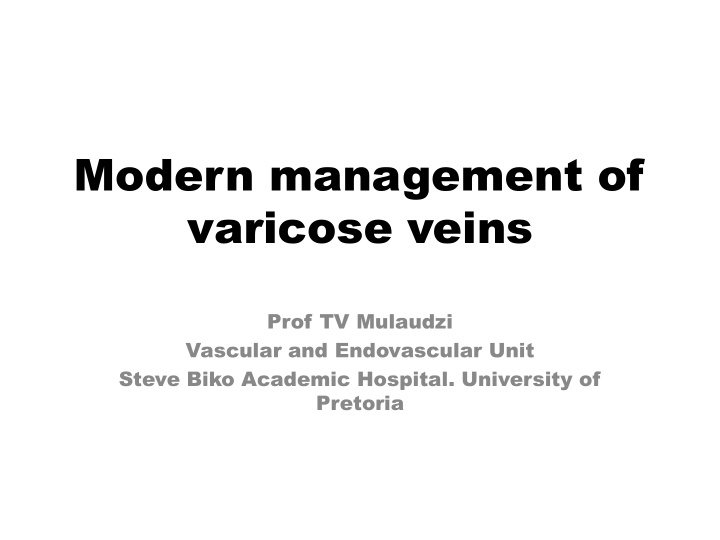



Modern management of varicose veins Prof TV Mulaudzi Vascular and Endovascular Unit Steve Biko Academic Hospital. University of Pretoria
History foot of the Acropolis 4 th c BC Ebers papyrus (ca. 1550 BC)
History Hippocrates (460-377 BC) • 1890, Friedrich Trendelenburg recognized the correlation between (1844-1925), GSV paper VV’s and ulceration
Epidemiology • 23% of adults • 6% have advanced disease • 11m(M) 22(F) • >2m active ulcer • Financial burden to patient and society • + 1 billion US $
Varicose veins • Thought to be cosmetic problem • Affect emotional wellbeing • Frequently cause of • Discomfort • Pain • Loss of working days • Disability • Low QOL
Varicose veins • Evaluation greatly improved with duplex u/s • Dramatic change in treatment due to endovenous therapy • EVLA • RFA • Sclerotherapy
Anatomy
Varicose vein diagnosis • Clinical evaluation • Duplex doppler • Rarely • Venogram • CTV • MRV • IVUS
Varicose vein treatment • Medical therapy • Compression therapy • Open venous surgery • High ligation, division and stripping • Ambulatory phlebectomy • Powered phlebectomy • Sclerotherapy • Endovenous thermal ablation • EVLA • RFA • Superheated steam
Medical therapy • Venoactive drugs • Treat symptoms of varicose veins • Reduce oedema • Accelerate ulcer healing • Mechanism of action unknown • Principle: improve venous tone and permeability • Insufficient evidence to support its global use Martinez MJ, Bonfill X, Moreno RM, Vargas E, Capella D. Phlebotonics for • venous insufficiency. Cochrane Database Syst Rev 2005: CD003229.
Sclerotherapy EVOLUTION AND DEVELOPMENT • First attempt : Zollikofer in 1682 with acid as ‘ sclerosant ’ • 1940 – 1950 : The procedure became accepted in Europe • 1946 : Sodium Tetradectyl sulphate (STS) developed – still used today • Initially Liquid Sclerotherapy outcomes poor in larger vessels • 1997 : Development of Foam Sclerotherapy for larger vessels
Sclerotherapy • Ind ndica cati tion on : • Con ontr trai aind ndica cati tion on : : • Residual vein after • Pregnancy surgery • Sup thromboplebitis • Telangiectases. at the time of procedure • Isolated small dilated veins • DVT • Previous hypersensitivity reaction to sclerosant
Sclerotherapy • Liquid sclerotherapy: smaller (telangiectases, small reticular, venulectases) • Foam sclerotherapy : larger veins – Tessari-like technique
Sclerotherapy • Adv dvan anta tage ge • Disa sadv dvan anta tage ge Cheap Not suitable for • • SFJ/SPJ obliteration Easy to learn • Truly an OPD procedure Thrombophebitis • • an be repeated many Pigmentation over skin • times More than 3 wks • No anesthesia required • compression is required
Endovenous thermal ablation • Minimal invasive • Done under U/S • Requires local tumescent anaesthesia • Done as outpatient in office • Better early QOL • Early return to normal activities
Endovenous thermal ablation mechanism of action • Causes direct thermal injury • Destruction of endothelium • Collagen denaturation of the media • Fibrotic and thrombotic occlusion
Endovenous thermal ablation contraindications • Inappropriate size • History of thrombophlebitis • Tortuous GSV • Aneurysmal SFJ • Relative contraindications • Uncorrectable coagulophathy • Liver dysfunction • Immobility • pregnancy
Technique 6 4 7 2 5 3 1
EVLA
RFA
Endovenous therapy outcome Pre therapy One week post therapy
Post procedural care • Maintain compression • Early ambulation • Thrombosis prophylaxis
EVLA COMPLICATIONS • Bruising: 75% • Paresthesia: 3% • DVT: 3% • Thrombophlebitis: 1.87% • Skin burns: 0.46% • Thrombus extension: 2.3% Kabnick LS. Vascular 2006;14(suppl 1):S31-2. • Knipp BS,et al.J Vasc Surg 2008;48:1538-45. •
EVLA vs SURGERY 2 YEAR FOLLOW UP SURGERY EVLA P No : Limbs 60 69 Clinical recurrent 7% 7% 0.44 Incompetent 3% 1% 0.45 perforator Recanalization GSV 2% 3% 0.23 Neovascularization 18% 1% 0.0001 Eur J Vasc Endovasc Surg (2009) 38, 203-207
RFA Complications • Paresthesia: 3.2% • Thrombophlebitis: 0.8% • Ecchymosis: 6.3% • Skin pigmentation: 2% • Thrombus extension: 2.6% Proebstle TM, et al. J Vasc Surg 2008;47:151-6. • Lawrence PF, et al. J Vasc Surg 2010;52:388-93 •
RFA reflux outcome • 5 years 83.8% of GSV’s were free from reflux – first • generation • 3 years - at 3 years ~ 95.7% free of reflux • - at 3 years ~ 92.6% probability of • occlusion • No blood flow within the treated GSV was observed ~ 92.6% • Merchant and Pichot ~ 2005 Journal l of Vascular lar Surgery Proebstle le et al of the European Closure Fast Study y Group – Journal of Vascular lar Surgery. . In • press ss
Endovenous therapy • Relief of symptoms • Reduced hospital stay • Most patients resume normal activities within 1-2 days • Local anesthesia • Good clinical outcome with minimal to no scarring, bruising or swelling
Murad HM, et al. J Vasc Surg 2011;53:49S-65S
THANK YOU
Recommend
More recommend